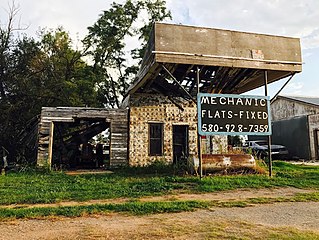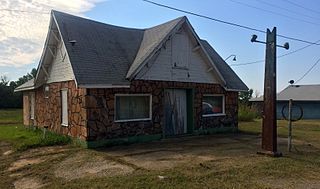
Ed Galloway's Totem Pole Park consists of eleven objects and one building on 14 acres in Rogers County, in northeastern Oklahoma. The park is ten miles (16 km) north-east of Claremore and is located 3.5 miles (6 km) east of historic U.S. Route 66 and Foyil. It was added to the National Register of Historic Places on March 30, 1999. The park is now owned and operated by the Rogers County Historical Society. The park's main totem pole is billed as the "World’s Largest Concrete Totem Pole."

Glenrio, formerly Rock Island, is an unincorporated community in both Deaf Smith County, Texas, and Quay County, New Mexico, United States. Located on the former U.S. Route 66, the ghost town sits on the Texas–New Mexico state line. It includes the Glenrio Historic District, which was listed on the National Register of Historic Places in 2007.

The Summit Inn was a historic U.S. Route 66 roadside diner built in 1952, located at the summit of Cajon Pass in San Bernardino County, California. The building was destroyed by the Blue Cut Fire on August 16, 2016. The building's current owners plan to rebuild the restaurant, as it appeared before the fire.

U.S. Route 66 in the state of Texas extended across the Texas Panhandle from its designation in 1926 to its decommissioning in 1985.

U.S. Route 66 is a former east–west United States Numbered Highway, running from Santa Monica, California to Chicago, Illinois. In Missouri, the highway ran from downtown St. Louis at the Mississippi River to the Kansas state line west of Joplin. The highway was originally Route 14 from St. Louis to Joplin and Route 1F from Joplin to Kansas. It underwent two major realignments and several lesser realignments in the cities of St. Louis, Springfield, and Joplin. Current highways covering several miles of the former highway include Route 100, Route 366, Route 266, Route 96, and Route 66. Interstate 44 (I-44) approximates much of US 66 between St. Louis and Springfield.

The historic U.S. Route 66, sometimes known as the Will Rogers Highway after Oklahoma native Will Rogers, ran from west to northeast across the state of Oklahoma, along the path now taken by Interstate 40 (I-40) and State Highway 66 (SH-66). It passed through Oklahoma City, Tulsa, and many smaller communities. West of the Oklahoma City area, it has been largely replaced by I-40; the few independent portions that are still state-maintained are now I-40 Business. However, from Oklahoma City northeast to Kansas, the bypassing I-44 is mostly a toll road, and SH-66 remains as a free alternate.

Ambler's Texaco Gas Station, also known as Becker's Marathon Gas Station, is a historic filling station located at the intersection of Old U.S. Route 66 and Illinois Route 17 in the village of Dwight, Illinois, United States. The station has been identified as the longest operating gas station along Route 66; it dispensed fuel for 66 continuous years until 1999. The station is a good example of a domestic style gas station and derives its most common names from ownership stints by two different men. North of the station is an extant outbuilding that once operated as a commercial icehouse. Ambler's was the subject of major restoration work from 2005–2007, and reopened as a Route 66 visitor's center in May 2007. It was added to the U.S. National Register of Historic Places in 2001.

Shea's Gas Station Museum Center piece The Mahan Filling Station located on Route 66 in Springfield, Illinois was transformed from a working Texaco, and later Marathon, station into a museum by owner Bill Shea and his wife Helen. The museum contained an eclectic mix of vintage gas station memorabilia collected over the last fifty years including the original gas pumps, wooden phone booths, signs, photos, and other mementos reminiscent of old Route 66 service stations. In February 2000, the former Mahan's Station, rumored to be the oldest filling station in Illinois, was moved 21 miles to its current location at Fulgenzi's. It has since been fully restored. The museum's guestbook boasts visitors from all over Europe and Asia and has become a destination for international travelers exploring the Mother Road. Due to his commitment to preserving Route 66 history and gas station memorabilia, plus his many years of quality service to his customers, Bill Shea and his shop were inducted into the Route 66 Hall of Fame in 1993. The entire Shea family was inducted in 2002. Bill Shea died in December 2013 and the gas station was sold. The museum contents were auctioned in 2015. As of 2015, the old Filling Station building was in use as the Fulgenzi's Pizza & Pasta.

The Boots Motel, a historic U.S. Route 66 motor hotel in Carthage, Missouri, opened in 1939 as the Boots Court at 107 S. Garrison Avenue.

The Wagon Wheel Motel, Café and Station in Cuba, Missouri, is a 19-room independently owned historic U.S. Route 66 restored motel which has been serving travelers since 1938. The site opened as a café in 1936; the motel has remained in continuous operation since 1938. The motel rooms were fully restored in 2010, adding modern amenities such as HDTV and wireless Internet.

Afton Station Packard Museum, a privately owned automotive museum on U.S. Route 66 in Afton, Oklahoma, was situated in a restored 1930s Eagle D-X filling station. It housed a showroom, 18 Packards & other vintage automobiles plus a collection of Route 66 memorabilia, including items from the now-demolished Buffalo Ranch Trading Post.

The Roundtop Filling Station, in Sherwood, Arkansas, United States, is one of only two structures in Sherwood to be listed on the National Register of Historic Places, the other being Sylvan Hills Country Club Golf Course.

Avant's Cities Service Station is a historic service station located at 220 S. Choctaw in El Reno, Oklahoma. The Art Deco building was constructed in 1933 as a service station for Cities Service Company to fuel automobiles traveling on U.S. Route 66. The station was added to the National Register of Historic Places in 2004.

The Magnolia Service Station is a historic service station located on Old U.S. Route 66 in Texola, Oklahoma. The station, an affiliate of the Magnolia Petroleum Company, opened circa 1930. The station was one of the westernmost in Oklahoma and became one of the first stops for eastbound travelers to buy gas and auto services in the state. The main building of the service station is representative of the "house" style of filling station; such stations resembled small houses in order to fit into residential areas.

The Jackson Conoco Service Station is a one-story brick structure located in El Reno, Oklahoma. Listed on the National Register of Historic Places in 2004, it was constructed by the Continental Oil Company in 1934 as a service station to serve the increasing automobile traffic along Route 66. Conoco built and operated many such facilities in the 1930s, all identical except for the positioning of the service bay; one other example is listed on the NRHP in Oklahoma, the Spraker Service Station in Vinita.
The Bridgeport Hill Service Station is a group of three buildings on Bridgeport Hill near Geary, Oklahoma. Originally constructed as a service station on U.S. Route 66, it includes a well house, an auto garage, and the gas station itself. It was listed on the National Register of Historic Places in 2003 as an example of a private business constructed to take advantage of the then-newly constructed US Highway 66.

The Threatt Filling Station, at the southwestern corner of the former U.S. Route 66 and Pottawatomi Rd. about 3 miles (4.8 km) east of Luther, Oklahoma, is a filling station built around 1915. The station closed in the 1970s. It was listed on the National Register of Historic Places in 1995.

The Texaco Service Station, at 201 W. 4th Ave. in Bristow, Oklahoma, was built in 1923. It was listed on the National Register of Historic Places in 1995.
















